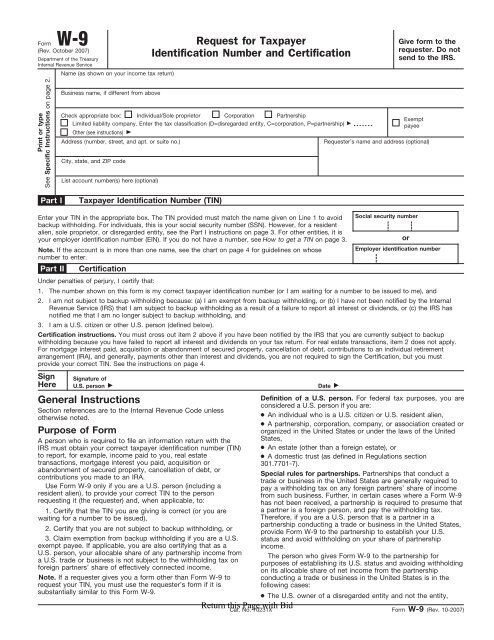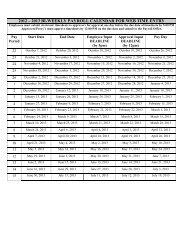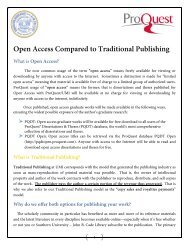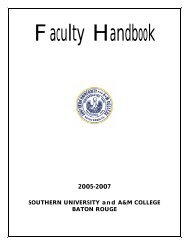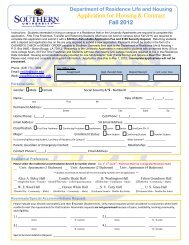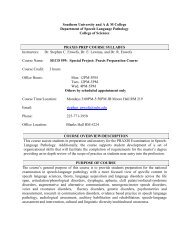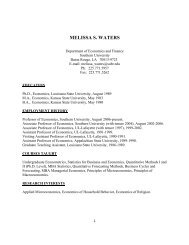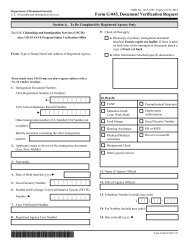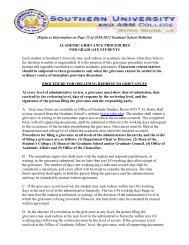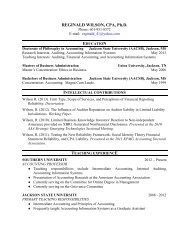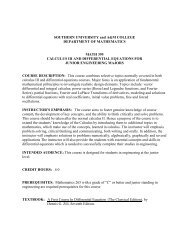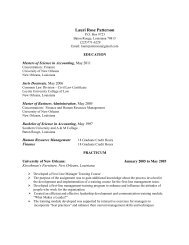Form W-9 (Rev. October 2007)
Form W-9 (Rev. October 2007)
Form W-9 (Rev. October 2007)
You also want an ePaper? Increase the reach of your titles
YUMPU automatically turns print PDFs into web optimized ePapers that Google loves.
<strong>Form</strong> W-9 Request for Taxpayer<br />
(<strong>Rev</strong>. <strong>October</strong> <strong>2007</strong>)<br />
Identification Number and Certification<br />
Department of the Treasury<br />
Internal <strong>Rev</strong>enue Service<br />
Name (as shown on your income tax return)<br />
Give form to the<br />
requester. Do not<br />
send to the IRS.<br />
Print or type<br />
See Specific Instructions on page 2.<br />
Business name, if different from above<br />
Check appropriate box: Individual/Sole proprietor Corporation Partnership<br />
Limited liability company. Enter the tax classification (D=disregarded entity, C=corporation, P=partnership) <br />
Other (see instructions) <br />
Address (number, street, and apt. or suite no.)<br />
City, state, and ZIP code<br />
List account number(s) here (optional)<br />
Exempt<br />
payee<br />
Requester’s name and address (optional)<br />
Part I<br />
Taxpayer Identification Number (TIN)<br />
Enter your TIN in the appropriate box. The TIN provided must match the name given on Line 1 to avoid<br />
backup withholding. For individuals, this is your social security number (SSN). However, for a resident<br />
alien, sole proprietor, or disregarded entity, see the Part I instructions on page 3. For other entities, it is<br />
your employer identification number (EIN). If you do not have a number, see How to get a TIN on page 3.<br />
Note. If the account is in more than one name, see the chart on page 4 for guidelines on whose<br />
number to enter.<br />
Part II<br />
Certification<br />
Under penalties of perjury, I certify that:<br />
Social security number<br />
or<br />
Employer identification number<br />
1. The number shown on this form is my correct taxpayer identification number (or I am waiting for a number to be issued to me), and<br />
2.<br />
I am not subject to backup withholding because: (a) I am exempt from backup withholding, or (b) I have not been notified by the Internal<br />
<strong>Rev</strong>enue Service (IRS) that I am subject to backup withholding as a result of a failure to report all interest or dividends, or (c) the IRS has<br />
notified me that I am no longer subject to backup withholding, and<br />
3. I am a U.S. citizen or other U.S. person (defined below).<br />
Certification instructions. You must cross out item 2 above if you have been notified by the IRS that you are currently subject to backup<br />
withholding because you have failed to report all interest and dividends on your tax return. For real estate transactions, item 2 does not apply.<br />
For mortgage interest paid, acquisition or abandonment of secured property, cancellation of debt, contributions to an individual retirement<br />
arrangement (IRA), and generally, payments other than interest and dividends, you are not required to sign the Certification, but you must<br />
provide your correct TIN. See the instructions on page 4.<br />
Sign<br />
Here<br />
Signature of<br />
U.S. person <br />
General Instructions<br />
Section references are to the Internal <strong>Rev</strong>enue Code unless<br />
otherwise noted.<br />
Purpose of <strong>Form</strong><br />
A person who is required to file an information return with the<br />
IRS must obtain your correct taxpayer identification number (TIN)<br />
to report, for example, income paid to you, real estate<br />
transactions, mortgage interest you paid, acquisition or<br />
abandonment of secured property, cancellation of debt, or<br />
contributions you made to an IRA.<br />
Use <strong>Form</strong> W-9 only if you are a U.S. person (including a<br />
resident alien), to provide your correct TIN to the person<br />
requesting it (the requester) and, when applicable, to:<br />
1. Certify that the TIN you are giving is correct (or you are<br />
waiting for a number to be issued),<br />
2. Certify that you are not subject to backup withholding, or<br />
3. Claim exemption from backup withholding if you are a U.S.<br />
exempt payee. If applicable, you are also certifying that as a<br />
U.S. person, your allocable share of any partnership income from<br />
a U.S. trade or business is not subject to the withholding tax on<br />
foreign partners’ share of effectively connected income.<br />
Note. If a requester gives you a form other than <strong>Form</strong> W-9 to<br />
request your TIN, you must use the requester’s form if it is<br />
substantially similar to this <strong>Form</strong> W-9.<br />
Return this Page with Bid<br />
Cat. No. 10231X<br />
Date <br />
Definition of a U.S. person. For federal tax purposes, you are<br />
considered a U.S. person if you are:<br />
● An individual who is a U.S. citizen or U.S. resident alien,<br />
● A partnership, corporation, company, or association created or<br />
organized in the United States or under the laws of the United<br />
States,<br />
● An estate (other than a foreign estate), or<br />
● A domestic trust (as defined in Regulations section<br />
301.7701-7).<br />
Special rules for partnerships. Partnerships that conduct a<br />
trade or business in the United States are generally required to<br />
pay a withholding tax on any foreign partners’ share of income<br />
from such business. Further, in certain cases where a <strong>Form</strong> W-9<br />
has not been received, a partnership is required to presume that<br />
a partner is a foreign person, and pay the withholding tax.<br />
Therefore, if you are a U.S. person that is a partner in a<br />
partnership conducting a trade or business in the United States,<br />
provide <strong>Form</strong> W-9 to the partnership to establish your U.S.<br />
status and avoid withholding on your share of partnership<br />
income.<br />
The person who gives <strong>Form</strong> W-9 to the partnership for<br />
purposes of establishing its U.S. status and avoiding withholding<br />
on its allocable share of net income from the partnership<br />
conducting a trade or business in the United States is in the<br />
following cases:<br />
● The U.S. owner of a disregarded entity and not the entity,<br />
<strong>Form</strong> W-9 (<strong>Rev</strong>. 10-<strong>2007</strong>)
<strong>Form</strong> W-9 (<strong>Rev</strong>. 10-<strong>2007</strong>) Page 2<br />
● The U.S. grantor or other owner of a grantor trust and not the<br />
trust, and<br />
● The U.S. trust (other than a grantor trust) and not the<br />
beneficiaries of the trust.<br />
Foreign person. If you are a foreign person, do not use <strong>Form</strong><br />
W-9. Instead, use the appropriate <strong>Form</strong> W-8 (see Publication<br />
515, Withholding of Tax on Nonresident Aliens and Foreign<br />
Entities).<br />
Nonresident alien who becomes a resident alien. Generally,<br />
only a nonresident alien individual may use the terms of a tax<br />
treaty to reduce or eliminate U.S. tax on certain types of income.<br />
However, most tax treaties contain a provision known as a<br />
“saving clause.” Exceptions specified in the saving clause may<br />
permit an exemption from tax to continue for certain types of<br />
income even after the payee has otherwise become a U.S.<br />
resident alien for tax purposes.<br />
If you are a U.S. resident alien who is relying on an exception<br />
contained in the saving clause of a tax treaty to claim an<br />
exemption from U.S. tax on certain types of income, you must<br />
attach a statement to <strong>Form</strong> W-9 that specifies the following five<br />
items:<br />
1. The treaty country. Generally, this must be the same treaty<br />
under which you claimed exemption from tax as a nonresident<br />
alien.<br />
2. The treaty article addressing the income.<br />
3. The article number (or location) in the tax treaty that<br />
contains the saving clause and its exceptions.<br />
4. The type and amount of income that qualifies for the<br />
exemption from tax.<br />
5. Sufficient facts to justify the exemption from tax under the<br />
terms of the treaty article.<br />
Example. Article 20 of the U.S.-China income tax treaty allows<br />
an exemption from tax for scholarship income received by a<br />
Chinese student temporarily present in the United States. Under<br />
U.S. law, this student will become a resident alien for tax<br />
purposes if his or her stay in the United States exceeds 5<br />
calendar years. However, paragraph 2 of the first Protocol to the<br />
U.S.-China treaty (dated April 30, 1984) allows the provisions of<br />
Article 20 to continue to apply even after the Chinese student<br />
becomes a resident alien of the United States. A Chinese<br />
student who qualifies for this exception (under paragraph 2 of<br />
the first protocol) and is relying on this exception to claim an<br />
exemption from tax on his or her scholarship or fellowship<br />
income would attach to <strong>Form</strong> W-9 a statement that includes the<br />
information described above to support that exemption.<br />
If you are a nonresident alien or a foreign entity not subject to<br />
backup withholding, give the requester the appropriate<br />
completed <strong>Form</strong> W-8.<br />
What is backup withholding? Persons making certain payments<br />
to you must under certain conditions withhold and pay to the<br />
IRS 28% of such payments. This is called “backup withholding.”<br />
Payments that may be subject to backup withholding include<br />
interest, tax-exempt interest, dividends, broker and barter<br />
exchange transactions, rents, royalties, nonemployee pay, and<br />
certain payments from fishing boat operators. Real estate<br />
transactions are not subject to backup withholding.<br />
You will not be subject to backup withholding on payments<br />
you receive if you give the requester your correct TIN, make the<br />
proper certifications, and report all your taxable interest and<br />
dividends on your tax return.<br />
Payments you receive will be subject to backup<br />
withholding if:<br />
1. You do not furnish your TIN to the requester,<br />
2. You do not certify your TIN when required (see the Part II<br />
instructions on page 3 for details),<br />
3. The IRS tells the requester that you furnished an incorrect<br />
TIN,<br />
4. The IRS tells you that you are subject to backup<br />
withholding because you did not report all your interest and<br />
dividends on your tax return (for reportable interest and<br />
dividends only), or<br />
5. You do not certify to the requester that you are not subject<br />
to backup withholding under 4 above (for reportable interest and<br />
dividend accounts opened after 1983 only).<br />
Certain payees and payments are exempt from backup<br />
withholding. See the instructions below and the separate<br />
Instructions for the Requester of <strong>Form</strong> W-9.<br />
Also see Special rules for partnerships on page 1.<br />
Penalties<br />
Failure to furnish TIN. If you fail to furnish your correct TIN to a<br />
requester, you are subject to a penalty of $50 for each such<br />
failure unless your failure is due to reasonable cause and not to<br />
willful neglect.<br />
Civil penalty for false information with respect to<br />
withholding. If you make a false statement with no reasonable<br />
basis that results in no backup withholding, you are subject to a<br />
$500 penalty.<br />
Criminal penalty for falsifying information. Willfully falsifying<br />
certifications or affirmations may subject you to criminal<br />
penalties including fines and/or imprisonment.<br />
Misuse of TINs. If the requester discloses or uses TINs in<br />
violation of federal law, the requester may be subject to civil and<br />
criminal penalties.<br />
Specific Instructions<br />
Name<br />
If you are an individual, you must generally enter the name<br />
shown on your income tax return. However, if you have changed<br />
your last name, for instance, due to marriage without informing<br />
the Social Security Administration of the name change, enter<br />
your first name, the last name shown on your social security<br />
card, and your new last name.<br />
If the account is in joint names, list first, and then circle, the<br />
name of the person or entity whose number you entered in Part I<br />
of the form.<br />
Sole proprietor. Enter your individual name as shown on your<br />
income tax return on the “Name” line. You may enter your<br />
business, trade, or “doing business as (DBA)” name on the<br />
“Business name” line.<br />
Limited liability company (LLC). Check the “Limited liability<br />
company” box only and enter the appropriate code for the tax<br />
classification (“D” for disregarded entity, “C” for corporation, “P”<br />
for partnership) in the space provided.<br />
For a single-member LLC (including a foreign LLC with a<br />
domestic owner) that is disregarded as an entity separate from<br />
its owner under Regulations section 301.7701-3, enter the<br />
owner’s name on the “Name” line. Enter the LLC’s name on the<br />
“Business name” line.<br />
For an LLC classified as a partnership or a corporation, enter<br />
the LLC’s name on the “Name” line and any business, trade, or<br />
DBA name on the “Business name” line.<br />
Other entities. Enter your business name as shown on required<br />
federal tax documents on the “Name” line. This name should<br />
match the name shown on the charter or other legal document<br />
creating the entity. You may enter any business, trade, or DBA<br />
name on the “Business name” line.<br />
Note. You are requested to check the appropriate box for your<br />
status (individual/sole proprietor, corporation, etc.).<br />
Exempt Payee<br />
If you are exempt from backup withholding, enter your name as<br />
described above and check the appropriate box for your status,<br />
then check the “Exempt payee” box in the line following the<br />
business name, sign and date the form.<br />
Return this Page with Bid
<strong>Form</strong> W-9 (<strong>Rev</strong>. 10-<strong>2007</strong>) Page 3<br />
Generally, individuals (including sole proprietors) are not exempt<br />
from backup withholding. Corporations are exempt from backup<br />
withholding for certain payments, such as interest and dividends.<br />
Note. If you are exempt from backup withholding, you should<br />
still complete this form to avoid possible erroneous backup<br />
withholding.<br />
The following payees are exempt from backup withholding:<br />
1. An organization exempt from tax under section 501(a), any<br />
IRA, or a custodial account under section 403(b)(7) if the account<br />
satisfies the requirements of section 401(f)(2),<br />
2. The United States or any of its agencies or<br />
instrumentalities,<br />
3. A state, the District of Columbia, a possession of the United<br />
States, or any of their political subdivisions or instrumentalities,<br />
4. A foreign government or any of its political subdivisions,<br />
agencies, or instrumentalities, or<br />
5. An international organization or any of its agencies or<br />
instrumentalities.<br />
Other payees that may be exempt from backup withholding<br />
include:<br />
6. A corporation,<br />
7. A foreign central bank of issue,<br />
8. A dealer in securities or commodities required to register in<br />
the United States, the District of Columbia, or a possession of<br />
the United States,<br />
9. A futures commission merchant registered with the<br />
Commodity Futures Trading Commission,<br />
10. A real estate investment trust,<br />
11. An entity registered at all times during the tax year under<br />
the Investment Company Act of 1940,<br />
12. A common trust fund operated by a bank under section<br />
584(a),<br />
13. A financial institution,<br />
14. A middleman known in the investment community as a<br />
nominee or custodian, or<br />
15. A trust exempt from tax under section 664 or described in<br />
section 4947.<br />
The chart below shows types of payments that may be<br />
exempt from backup withholding. The chart applies to the<br />
exempt payees listed above, 1 through 15.<br />
IF the payment is for . . .<br />
Interest and dividend payments<br />
Broker transactions<br />
Barter exchange transactions<br />
and patronage dividends<br />
Payments over $600 required<br />
to be reported and direct<br />
1<br />
sales over $5,000<br />
1<br />
THEN the payment is exempt<br />
for . . .<br />
All exempt payees except<br />
for 9<br />
Exempt payees 1 through 13.<br />
Also, a person registered under<br />
the Investment Advisers Act of<br />
1940 who regularly acts as a<br />
broker<br />
Exempt payees 1 through 5<br />
Generally, exempt payees<br />
2<br />
1 through 7<br />
See <strong>Form</strong> 1099-MISC, Miscellaneous Income, and its instructions.<br />
2<br />
However, the following payments made to a corporation (including gross<br />
proceeds paid to an attorney under section 6045(f), even if the attorney is a<br />
corporation) and reportable on <strong>Form</strong> 1099-MISC are not exempt from<br />
backup withholding: medical and health care payments, attorneys’ fees, and<br />
payments for services paid by a federal executive agency.<br />
Part I. Taxpayer Identification<br />
Number (TIN)<br />
Enter your TIN in the appropriate box. If you are a resident<br />
alien and you do not have and are not eligible to get an SSN,<br />
your TIN is your IRS individual taxpayer identification number<br />
(ITIN). Enter it in the social security number box. If you do not<br />
have an ITIN, see How to get a TIN below.<br />
If you are a sole proprietor and you have an EIN, you may<br />
enter either your SSN or EIN. However, the IRS prefers that you<br />
use your SSN.<br />
If you are a single-member LLC that is disregarded as an<br />
entity separate from its owner (see Limited liability company<br />
(LLC) on page 2), enter the owner’s SSN (or EIN, if the owner<br />
has one). Do not enter the disregarded entity’s EIN. If the LLC is<br />
classified as a corporation or partnership, enter the entity’s EIN.<br />
Note. See the chart on page 4 for further clarification of name<br />
and TIN combinations.<br />
How to get a TIN. If you do not have a TIN, apply for one<br />
immediately. To apply for an SSN, get <strong>Form</strong> SS-5, Application<br />
for a Social Security Card, from your local Social Security<br />
Administration office or get this form online at www.ssa.gov. You<br />
may also get this form by calling 1-800-772-1213. Use <strong>Form</strong><br />
W-7, Application for IRS Individual Taxpayer Identification<br />
Number, to apply for an ITIN, or <strong>Form</strong> SS-4, Application for<br />
Employer Identification Number, to apply for an EIN. You can<br />
apply for an EIN online by accessing the IRS website at<br />
www.irs.gov/businesses and clicking on Employer Identification<br />
Number (EIN) under Starting a Business. You can get <strong>Form</strong>s W-7<br />
and SS-4 from the IRS by visiting www.irs.gov or by calling<br />
1-800-TAX-FORM (1-800-829-3676).<br />
If you are asked to complete <strong>Form</strong> W-9 but do not have a TIN,<br />
write “Applied For” in the space for the TIN, sign and date the<br />
form, and give it to the requester. For interest and dividend<br />
payments, and certain payments made with respect to readily<br />
tradable instruments, generally you will have 60 days to get a<br />
TIN and give it to the requester before you are subject to backup<br />
withholding on payments. The 60-day rule does not apply to<br />
other types of payments. You will be subject to backup<br />
withholding on all such payments until you provide your TIN to<br />
the requester.<br />
Note. Entering “Applied For” means that you have already<br />
applied for a TIN or that you intend to apply for one soon.<br />
Caution: A disregarded domestic entity that has a foreign owner<br />
must use the appropriate <strong>Form</strong> W-8.<br />
Part II. Certification<br />
To establish to the withholding agent that you are a U.S. person,<br />
or resident alien, sign <strong>Form</strong> W-9. You may be requested to sign<br />
by the withholding agent even if items 1, 4, and 5 below indicate<br />
otherwise.<br />
For a joint account, only the person whose TIN is shown in<br />
Part I should sign (when required). Exempt payees, see Exempt<br />
Payee on page 2.<br />
Signature requirements. Complete the certification as indicated<br />
in 1 through 5 below.<br />
1. Interest, dividend, and barter exchange accounts<br />
opened before 1984 and broker accounts considered active<br />
during 1983. You must give your correct TIN, but you do not<br />
have to sign the certification.<br />
2. Interest, dividend, broker, and barter exchange<br />
accounts opened after 1983 and broker accounts considered<br />
inactive during 1983. You must sign the certification or backup<br />
withholding will apply. If you are subject to backup withholding<br />
and you are merely providing your correct TIN to the requester,<br />
you must cross out item 2 in the certification before signing the<br />
form.<br />
Return this Page with Bid
<strong>Form</strong> W-9 (<strong>Rev</strong>. 10-<strong>2007</strong>) Page 4<br />
3. Real estate transactions. You must sign the certification.<br />
You may cross out item 2 of the certification.<br />
4. Other payments. You must give your correct TIN, but you<br />
do not have to sign the certification unless you have been<br />
notified that you have previously given an incorrect TIN. “Other<br />
payments” include payments made in the course of the<br />
requester’s trade or business for rents, royalties, goods (other<br />
than bills for merchandise), medical and health care services<br />
(including payments to corporations), payments to a<br />
nonemployee for services, payments to certain fishing boat crew<br />
members and fishermen, and gross proceeds paid to attorneys<br />
(including payments to corporations).<br />
5. Mortgage interest paid by you, acquisition or<br />
abandonment of secured property, cancellation of debt,<br />
qualified tuition program payments (under section 529), IRA,<br />
Coverdell ESA, Archer MSA or HSA contributions or<br />
distributions, and pension distributions. You must give your<br />
correct TIN, but you do not have to sign the certification.<br />
What Name and Number To Give the Requester<br />
For this type of account:<br />
1. Individual<br />
2. Two or more individuals (joint<br />
account)<br />
3. Custodian account of a minor<br />
(Uniform Gift to Minors Act)<br />
4. a. The usual revocable savings<br />
trust (grantor is also trustee)<br />
b. So-called trust account that is<br />
not a legal or valid trust under<br />
state law<br />
5. Sole proprietorship or disregarded<br />
entity owned by an individual<br />
For this type of account:<br />
6. Disregarded entity not owned by an<br />
individual<br />
7. A valid trust, estate, or pension trust<br />
8. Corporate or LLC electing<br />
corporate status on <strong>Form</strong> 8832<br />
9. Association, club, religious,<br />
charitable, educational, or other<br />
tax-exempt organization<br />
10. Partnership or multi-member LLC<br />
11. A broker or registered nominee<br />
12. Account with the Department of<br />
Agriculture in the name of a public<br />
entity (such as a state or local<br />
government, school district, or<br />
prison) that receives agricultural<br />
program payments<br />
Give name and SSN of:<br />
The individual<br />
The actual owner of the account or,<br />
if combined funds, the first<br />
1<br />
individual on the account<br />
The minor 2<br />
The grantor-trustee 1<br />
The actual owner 1<br />
The owner 3<br />
The owner<br />
Give name and EIN of:<br />
Legal entity 4<br />
The corporation<br />
The organization<br />
The partnership<br />
The broker or nominee<br />
The public entity<br />
1<br />
List first and circle the name of the person whose number you furnish. If only one person<br />
on a joint account has an SSN, that person’s number must be furnished.<br />
2<br />
Circle the minor’s name and furnish the minor’s SSN.<br />
3<br />
You must show your individual name and you may also enter your business or “DBA”<br />
name on the second name line. You may use either your SSN or EIN (if you have one),<br />
but the IRS encourages you to use your SSN.<br />
4<br />
List first and circle the name of the trust, estate, or pension trust. (Do not furnish the TIN<br />
of the personal representative or trustee unless the legal entity itself is not designated in<br />
the account title.) Also see Special rules for partnerships on page 1.<br />
Note. If no name is circled when more than one name is listed,<br />
the number will be considered to be that of the first name listed.<br />
Secure Your Tax Records from Identity Theft<br />
Identity theft occurs when someone uses your personal<br />
information such as your name, social security number (SSN), or<br />
other identifying information, without your permission, to commit<br />
fraud or other crimes. An identity thief may use your SSN to get<br />
a job or may file a tax return using your SSN to receive a refund.<br />
To reduce your risk:<br />
● Protect your SSN,<br />
● Ensure your employer is protecting your SSN, and<br />
● Be careful when choosing a tax preparer.<br />
Call the IRS at 1-800-829-1040 if you think your identity has<br />
been used inappropriately for tax purposes.<br />
Victims of identity theft who are experiencing economic harm<br />
or a system problem, or are seeking help in resolving tax<br />
problems that have not been resolved through normal channels,<br />
may be eligible for Taxpayer Advocate Service (TAS) assistance.<br />
You can reach TAS by calling the TAS toll-free case intake line<br />
at 1-877-777-4778 or TTY/TDD 1-800-829-4059.<br />
Protect yourself from suspicious emails or phishing<br />
schemes. Phishing is the creation and use of email and<br />
websites designed to mimic legitimate business emails and<br />
websites. The most common act is sending an email to a user<br />
falsely claiming to be an established legitimate enterprise in an<br />
attempt to scam the user into surrendering private information<br />
that will be used for identity theft.<br />
The IRS does not initiate contacts with taxpayers via emails.<br />
Also, the IRS does not request personal detailed information<br />
through email or ask taxpayers for the PIN numbers, passwords,<br />
or similar secret access information for their credit card, bank, or<br />
other financial accounts.<br />
If you receive an unsolicited email claiming to be from the IRS,<br />
forward this message to phishing@irs.gov. You may also report<br />
misuse of the IRS name, logo, or other IRS personal property to<br />
the Treasury Inspector General for Tax Administration at<br />
1-800-366-4484. You can forward suspicious emails to the<br />
Federal Trade Commission at: spam@uce.gov or contact them at<br />
www.consumer.gov/idtheft or 1-877-IDTHEFT(438-4338).<br />
Visit the IRS website at www.irs.gov to learn more about<br />
identity theft and how to reduce your risk.<br />
Privacy Act Notice<br />
Section 6109 of the Internal <strong>Rev</strong>enue Code requires you to provide your correct TIN to persons who must file information returns with the IRS to report interest,<br />
dividends, and certain other income paid to you, mortgage interest you paid, the acquisition or abandonment of secured property, cancellation of debt, or<br />
contributions you made to an IRA, or Archer MSA or HSA. The IRS uses the numbers for identification purposes and to help verify the accuracy of your tax return.<br />
The IRS may also provide this information to the Department of Justice for civil and criminal litigation, and to cities, states, the District of Columbia, and U.S.<br />
possessions to carry out their tax laws. We may also disclose this information to other countries under a tax treaty, to federal and state agencies to enforce federal<br />
nontax criminal laws, or to federal law enforcement and intelligence agencies to combat terrorism.<br />
You must provide your TIN whether or not you are required to file a tax return. Payers must generally withhold 28% of taxable interest, dividend, and certain other<br />
payments to a payee who does not give a TIN to a payer. Certain penalties may also apply.<br />
Return this Page with Bid


